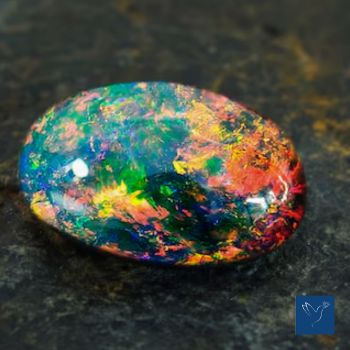


Discover what makes a synthetic opal different from a natural opal. Learn about its creation process, visual similarities, durability, and buying ability.
If fascination had a tangible form, it would surely be an opal. For centuries, this gemstone has retained its status as the most enchanting stone, and we’re totally in love with the way it appears. What makes it stand apart is the color play, which compels us to fix our gaze on it. However, if you want to buy opal gemstone online, know that there are so many synthetic and fake varieties out there in the market. They look exactly like the real opals but lack the energetic value and a charm that real stones carry. So, how do you tell the difference as an aware buyer? In this blog, we’ll teach you that!
A synthetic or a lab created opal is made in a controlled environment to replicate the same structure and beauty of a natural opal stone. These aren’t plastic fakes but are composed of hydrated silica, just like the real thing. In fact, some lab opals even have a better structure and more consistent play-of-color than natural ones.
But here’s the key difference: natural opals form over millions of years whereas synthetic opals take a few months. They’re grown using cutting-edge technology that stacks silica particles in a similar way, allowing them to reflect light and produce that famous opalescence.
If you’re comparing synthetic with a real opal, remember this: both may be beautiful, but only one was formed deep within the Earth and offers the healing energy.
When buying gemstones online, it helps to know where you’re shopping from. The best website to buy gemstones will clearly label each stone, share treatment info, and give you real (unedited) photos. If it says “natural stone” but offers no certificate or details on origin, be cautious.
Lab-created opals are not inherently bad. In fact, they’re a budget-friendly option for those who love the look of opal without the premium price. But honesty is the real currency in the gem world, and if a seller doesn’t disclose whether an opal is synthetic, that’s a red flag. Apart from that, if you need an opal for healing purposes, then only the real stone would do the job.
That’s why you should always ask questions about the treatment: has the opal been dyed, stabilized, or backed with another material? This transparency separates reputable sellers from the rest.
If you’re ever unsure, request a close-up video in natural light. Or better yet, shop from certified sellers who guarantee authenticity.
Apart from synthetic and natural opals, there are also completely fake opals in the market. These are usually made from resin, plastic, or glass. They may be coated with holographic foil or painted to mimic play-of-color.
Here are the most common types:
These fakes not only lack durability but also have no metaphysical properties. If you’re buying an opal for spiritual or chakra work, these should be avoided.
Price is often the easiest way to spot a fake or lab-created opal. High-quality natural opal stones are rare and can be quite expensive, especially if they come from reputable sources like Australia or Ethiopia.
On the other hand, synthetic opals are much more affordable. If a seller offers a big, vibrant opal for an incredibly low price without any certifications, it’s likely not a natural stone.
Whether you’re after natural or lab-created stones, a few rules always apply:
When in doubt, talk to the seller directly. A knowledgeable response is often a good indicator of reliability.
Choosing between synthetic vs real opal depends on what matters most to you: beauty, budget, authenticity, or energy. There’s no wrong answer, just different preferences.
What matters is that you know what you’re buying, and you feel confident in that choice. Whether it’s for jewelry or healing, opals are a joy to own as long as you buy them from the right place. So, next time you decide to buy opal online.
